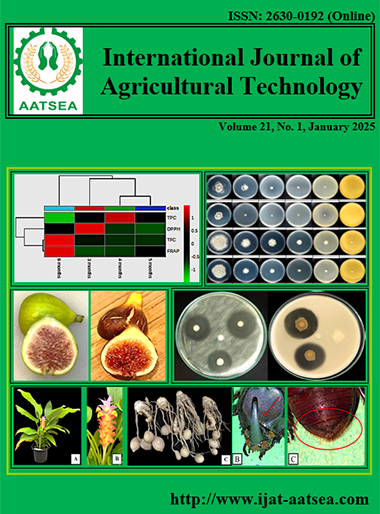Adulticidal activity of star anise, turmeric, cloves and combinations against houseflies
Main Article Content
Abstract
The small droplet size could increase the absorbed ingredients and high stability. The star anise nanoemulsion was determined optimum efficacy, with a 1% concentration resulting in the highest knockdown and mortality rate of 100%. Its KT50 and mortality effective values were 28 min and 36 times, respectively. Furthermore, the adult stage of houseflies is found to be susceptible to star anise nanoemulsion. In contrast, cypermethrin was less toxic to it, with a high KT50 and resistance to adult houseflies. Consequently, the star anise nanoemulsion could be developed into an efficient and safe environment for controlling housefly populations.
Article Details

This work is licensed under a Creative Commons Attribution-NonCommercial-NoDerivatives 4.0 International License.
References
Ariyaprakai, S. (2017). Nanoemulsion production by simple and low energy method. Food and Applied Bioscience Journal, 5:155-64.
Aungtikun, J., Soonwera, M. and Sittichok, S. (2021). Insecticidal synergy of essential oils from Cymbopogon citratus (Stapf.), Myristica fragrans (Houtt.), and Illicium verun Hook.f. and their major active constitutes. Industrial Crops and Products, 164:113386.
Chaudhari, A. K., Singh, V. K., Kedia, A., Das, S. and Dubey, N. K. (2021). Essential oils and their bioactive compounds as eco-friendly novel green pesticides for management of storage insect pests: prospects and retrospects. Environmental Science and Pollution Research, 28:18918-18940.
Crawford, M. J., Croucher, A. and Hutson, D. H. (1981). Metabolism of cis- and trans-cypermethrin in rats. balance and tissue retention study (insecticide). Journal of Agricultural and Food Chemistry, 29:130-135.
Duhan, J., Kumar, R., Kumar, N., Kaur, P., Nehra, K. and Duhan, S. (2017). Nanotechnology: The new perspective in precision agriculture. Biotechnology Reports, 15:11-23.
Hasan, A. H. and Leong, K. P. (2018). Growth of Musca domestica (Diptera: Muscidae) and Sarcophaga dux (Diptera: Sarcophagidae) larvae in poultry and livestock manures: Implication for animal waste management, Journal of Asia-Pacific Entomology, 21:880-884.
Iqbal, W., Malik, M. F., Sarwar, M. K., Azam, I., Iram, N. and Rashda, A. (2014). Role of housefly (Musca domestica, Diptera; Muscidae) as a disease vector; a review. Journal of Entomology and Zoology Studies, 2:159-163.
Isman, M. B. (2006). Botanical Insecticides, Deterrents, and Repellents in Modern Agriculture and an Increasingly Regulated World. Annual Review of Entomology, 51:45-66.
Isman, M. B. (2020). Botanical insecticides in the twenty-first century - fulfilling their promise? Annual Review of Entomology, 65:233-249.
Jintapattanakit, A. (2018). Preparation of nanoemulsions by phase inversion temperature (PIT). Pharmaceutical Sciences Asia, 42:1-12.
Khamesipour F., Lankarani K. B., Hoharvar B. and Kenti T. E. (2018). A systemic review of human pathogens carried by the housefly (Musca domestica L.) BMC Public Health,18:1049.
Kim, Y. G., Lee, J. H., Gwon, G., Kim, S. I., Park, J. G. and Lee, J. (2016). Essential oils and eugenols inhibit biofilm formation and the virulence of Escherichia coli O157:H7. Scientific Reports, 6:36377.
McClements, D. J. and Rao, J. (2011). Food-grade nanoemulsions: formulation, fabrication, properties, performance, biological fate, and potential toxicity. Critical Reviews in Food Science and Nutrition, 51:285-330.
Kumar, S. and Kumari, R. (2019). Cinnamomum: review article of essential oil compounds, ethnobotany, antifungal and antibacterial effects. Open Access Journal of Science, 3:13-16.
Mochiah, M. B., Banful, B. and Fening, K. (2011). Botanicals for the management of insect pests in organic vegetable production. International Journal of Nematology and Entomology, 3:85-97.
Mohammadi, M. K., Riahi, S. and Boek, E. S. (2022). Developing novel bio-nano catalyst well clean up fluid to remove formation damage induced by polymeric water-based drilling fluids. Journal of Petroleum Science and Engineering, 210:109809.
Noichinda, W. and Suppavorasatit, I. (2019). Enhancement of Essential Oil Stability by Cyclodextrins Inclusion Complex. Journal of Food Technology, Siam University, 14:108-119.
Passara, H., Sittichok, S., Sinthusiri, J., Moungthipmalai, T., Puwanad, C., Murata, K. and Soonwera, M. (2024). Ovicidal toxicity and morphological changes in housefly eggs induced by the essential oils of star anise and lemongrass and their main constituents. Insects, 15:481.
Puwanard, C. and Soonwera, M. (2022). Ovicidal and adulticidal activities of Cymbopogon citratus (DC.) Stapf and Illicium verum Hook. f. against Aedes aegypti (Linn.). International Journal of Agricultural Technology, 18:319-328.
Singh, A. K., Tiwari, M. N., Prakash, O. and Singh, M. P. (2012). A current review of cypermethrin-induced neurotoxicity and nigrostriatal dopaminergic neurodegeneration. Current Neuropharmacology,10:64-71.
Sinthusiri, J. and Soonwera, M. (2014). Oviposition deterrent and ovicidal activities of seven herbal essential oils against female adults of housefly, Musca domestica. Parasitology Research, 113:3015-3022.
Soonwera, M. and Sittichok, S. (2020). Adulticidal activities of Cymbopogon citratus (Stapf.) and Eucalyptus globulus (Labill.) essential oils and of their synergistic combinations against Aedes aegypti (L.), Aedes albopictus (Skuse), and Musca domestica (L.). Environmental Science and Pollution Research, 27:20201-20214.
Wang, J. N., Hou, J., Wu, Y. Y., Guo, S., Liu, Q. M., Li, T. Q. and Gong, Z. Y. (2019). Resistance of house fly, Musca domestica L. (Diptera: Muscidae), to five insecticides in Zhejiang province, China: the situation in 2017. Canadian Journal of Infectious Diseases and Medical Microbiology, 2019:4851914-4851914.
Wang, Y., Zou, J., Jia, Y., Zhang, X., Wang, C., Shi, Y., Goa, D., Wu, Z. and Wang, F. (2021). The mechanism of lavender essential oil in the treatment of acute colitis based on “quantity–effect” weight coefficient network pharmacology. Frontiers in Antibiotics, 12:644140.
World Health Organization (WHO) (2018). Test procedures for insecticide resistance monitoring in malaria vector mosquitoes – 2nd ed. Geneva: World Health Organization. Retrieved from https://apps.who.int/iris/bitstream/handle/10665/250677/9789241511575 eng.pdf.

